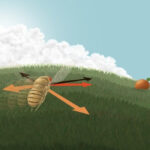Spotted lanternflies are causing significant concern due to their potential to harm fruit and forest industries. Early detection and understanding these pests are crucial steps in mitigating economic and ecological losses. To effectively combat them, it’s important to know their origins. So, Where Did Lantern Flies Come From?
Tracing Back to Their Native Land: Asia
The spotted lanternfly ( Lycorma delicatula ) is not native to the United States. This invasive species actually originates from Asia, with its native range spanning across parts of China, India, and Vietnam. In these regions, the spotted lanternfly is naturally occurring and often kept in check by natural predators and environmental factors that maintain an ecological balance.
The spotted lanternfly is an invasive pest not native to the US, originating from Asia.
The Journey to New Lands: Introduction and Spread
How did this insect, native to Asia, become a pest in places like North America and parts of Europe? The primary pathway for the spotted lanternfly’s introduction to new environments is believed to be through international trade and shipping. Egg masses, which are laid on various surfaces, can unknowingly be transported on goods, vehicles, and other materials.
The first detection of spotted lanternflies in the United States was in Pennsylvania in 2014. It is believed they arrived as egg masses on a stone shipment from Asia. Without their natural predators present in these new environments, and with ample host plants available, the spotted lanternfly population has been able to grow and spread rapidly, leading to their classification as a significant invasive pest.
Identifying Spotted Lanternflies: Key Characteristics
Regardless of their origin, knowing how to identify spotted lanternflies at all stages of their lifecycle is essential for control and prevention. They have distinct appearances as nymphs, adults, and eggs.
Nymphs
Young spotted lanternflies, known as nymphs, undergo several stages of development called instars. Early instar nymphs are black with white spots. As they mature through the later instars, they develop red patches alongside the black and white markings, becoming increasingly vibrant in color.
Different nymph stages of the spotted lanternfly, showing the progression from black and white to red coloration.
Spotted lanternfly nymphs are often found clustered together on plants.
Close-up view of spotted lanternfly nymphs displaying their characteristic spots.
Nymphs hatching from spotted lanternfly eggs.
Early instar nymph of the spotted lanternfly.
Adults
Adult spotted lanternflies are striking in appearance, measuring about 1 inch long and 1/2 inch wide. Their forewings are a light brown-grey with black spots, while their hindwings are brightly colored with scarlet red, contrasted with black spots and white and black bars. This vibrant underwing is typically hidden when the lanternfly is at rest.
The back of an adult spotted lanternfly showing the spotted forewings.
Frontal view of an adult spotted lanternfly.
Striking hindwings of an adult spotted lanternfly revealed.
Eggs
Spotted lanternfly egg masses are laid in the fall and can be found through spring. Freshly laid egg masses appear as a wet, greyish-brown and mud-like smear. Over time, they dry and can become cracked, resembling dry mud. These egg masses, containing 30-50 eggs, can be deposited on a wide variety of smooth surfaces including trees, rocks, vehicles, and outdoor furniture.
Adult spotted lanternfly alongside laid egg masses.
Spotted lanternfly egg mass on a log, resembling cracked mud.
Signs of Infestation Beyond Visual Identification
Besides seeing the insects themselves, there are other signs of a spotted lanternfly infestation:
- Oozing Sap: Spotted lanternflies feed on plant sap, excreting a sticky substance called honeydew.
- Fermented Odor: Honeydew can ferment, producing a noticeable rotten smell.
- Tree-of-Heaven: While they feed on many plants, tree-of-heaven is a favored host. Identifying this tree can be a good starting point for spotting lanternflies.
Why Spotted Lanternflies are a Major Concern
Spotted lanternflies pose a threat due to their feeding habits. They feed on sap from a wide range of plants, including fruit trees, grapevines, and hardwood trees. This feeding can weaken plants, reduce yields, and in some cases, even kill them. The honeydew they produce not only attracts other pests but also promotes the growth of sooty mold, which can further damage plants by hindering photosynthesis.
Taking Action to Prevent Spread
Understanding where lantern flies came from highlights how easily invasive species can travel and establish themselves in new regions. Preventing further spread relies on vigilance and action:
- Regular Inspections: Check plants and trees for signs of infestation, especially at dusk and night.
- Vehicle Checks: Before traveling, especially from quarantine zones, inspect vehicles for insects and egg masses.
- Destroy Egg Masses: Scrape egg masses into a bag with hand sanitizer or rubbing alcohol to kill them.
- Quarantine Awareness: Be aware of quarantine zones and comply with guidelines when moving from these areas.
- Inspect Moved Items: Check outdoor items, shipping containers, and goods for egg masses and insects.
A cluster of spotted lanternfly adults and nymphs, highlighting their tendency to gather in large numbers.
Group of adult spotted lanternflies.
A late instar nymph of the spotted lanternfly.
By understanding the origin of spotted lanternflies, recognizing their appearance, and taking preventive steps, we can collectively work towards minimizing their impact and protecting our ecosystems and industries. For further guidance and control options, contact your local Cooperative Extension Agent.
